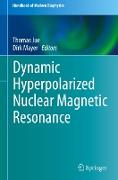- Start
- Dynamic Hyperpolarized Nuclear Magnetic Resonance
Dynamic Hyperpolarized Nuclear Magnetic Resonance
Angebote / Angebote:
This is the first book in the series to focus on dynamic hyperpolarized nuclear magnetic resonance, a burgeoning topic in biophysics. The volume follows the format and style of the Handbook of Modern Biophysics series and expands on topics already discussed in previous volumes. It builds a theoretical and experimental framework for students and researchers who wish to investigate the biophysics and biomedical application of dynamic hyperpolarized NMR. All contributors are internationally recognized experts, lead the dynamic hyperpolarized NMR field, and have first-hand knowledge of the chapter material.
The book covers the following topics:
Hyperpolarization by dissolution Dynamic Nuclear Polarization
Design considerations for implementing a hyperpolarizer
Chemical Shift Imaging with Dynamic Hyperpolarized NMR
Signal Sampling Strategies in Dynamic Hyperpolarized NMR
Kinetic Modeling of Enzymatic Reactions in Analyzing Hyperpolarized NMR Data
Using Hyperpolarized NMR to Understand Biochemistry from Cells to Humans
Innovating Metabolic Biomarkers for Hyperpolarized NMR
New Insights into Metabolic Regulation from Hyperpolarized 13C MRS/MRI Studies
Novel Views on Heart Function from Dynamic Hyperpolarized NMR
Insights on Lactate Metabolism in Skeletal Muscle based on 13C Dynamic Nuclear Polarization Studies
About the Editors
Dirk Mayer is Professor of Diagnostic Radiology and Nuclear Medicine at the University of Maryland and is the Director of Metabolic Imaging. He is a recognized expert on dynamic nuclear polarization (DNP) MRI-based imaging techniques and has optimized acquisition and reconstruction techniques, has constructed kinetic modeling for quantitative analysis, and has developing new probes.
Thomas Jue is Professor of Biochemistry and Molecular Medicine at the University of California Davis. He is an internationally recognized expert in developing and applying magnetic resonance techniques to study animal as well as human physiology in vivo. He served as a Chair of the Biophysics Graduate Group Program at UC Davis, where he started to redesign a graduate curriculum that balances physical science/mathematics formalism and biomedical perspective in order to promote interest at the interface of physical science, engineering, mathematics, biology, and medicine. The Handbook of Modern Biophysics represents an aspect of that effort.
Folgt in ca. 15 Arbeitstagen
